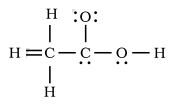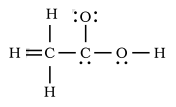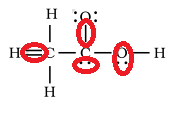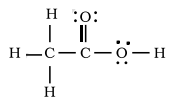
The Lewis structure of \[C{H_3}COOH\] as shown below is incorrect. Draw the correct Lewis structure of acetic acid.

Answer
220.8k+ views
Hint: A Lewis structure of a compound or an isolated atom is the simplified method of representation of the valence shell electrons of the molecule of the compound or of the isolated atom. It is used to represent the arrangement of electrons around each individual atom of a molecule. Bonding electrons are represented as a line between the two atoms while electrons not participating in the bond formation are shown as dots.
Complete Step by Step Solution:
As given in the question, the chemical formula of the compound is \[C{H_3}COOH\] and its common name is acetic acid.
The given Lewis structure in the diagram is:-

Image - The incorrect Lewis structure of Acetic acid provided in the question.
From the above diagram, a few incorrect details are marked out in the diagram below.

Image - The incorrect Lewis structure of Acetic acid with the mistakes marked out.
A) Here, the first mistake is the double bonding representation between Carbon and hydrogen atoms. A hydrogen atom has a single electron in its outermost shell, hence only one electron can participate in the bond formation. So, there must be a single bond instead of the double bond shown in the figure.
B) There is a single bond representation between the oxygen atom and the carbon atom. Oxygen has the atomic number of 8. Two of its electron are present in the inner shell while the rest of 6 electrons are found in the outermost shell. Here, there must be a double bond representing covalent bonding between the second carbon atom’s two electrons and two electrons of the Oxygen atom. The remaining two pairs of electrons which do not participate in the bond formation must remain the same.
C) Lone pair representation of the carbon atom is incorrect. Carbon has only four electrons in the outermost shell i.e. its E.C is 2,4. Hence after four of its electrons are involved in bond formation, there won’t be any remaining lone pair.
D) Oxygen is shown to have a single lone pair of electrons. As already mentioned above, oxygen has six electrons in its valence shell, hence after two of its electrons participate in bond formation, the remaining four electrons must be represented as two lone pairs of electrons.
After making all the necessary corrections, as mentioned above, the final Lewis dot structure of Acetic acid is:-

Image - The correct Lewis dot structure of Acetic acid.
Note: Lewis structures are not used to represent the geometry of molecules. It also refrains from explaining the cause of the bond formation and the nature of sharing of electrons between the atoms. It is the simplest and most limited theory on the electronic structure.
Complete Step by Step Solution:
As given in the question, the chemical formula of the compound is \[C{H_3}COOH\] and its common name is acetic acid.
The given Lewis structure in the diagram is:-

Image - The incorrect Lewis structure of Acetic acid provided in the question.
From the above diagram, a few incorrect details are marked out in the diagram below.

Image - The incorrect Lewis structure of Acetic acid with the mistakes marked out.
A) Here, the first mistake is the double bonding representation between Carbon and hydrogen atoms. A hydrogen atom has a single electron in its outermost shell, hence only one electron can participate in the bond formation. So, there must be a single bond instead of the double bond shown in the figure.
B) There is a single bond representation between the oxygen atom and the carbon atom. Oxygen has the atomic number of 8. Two of its electron are present in the inner shell while the rest of 6 electrons are found in the outermost shell. Here, there must be a double bond representing covalent bonding between the second carbon atom’s two electrons and two electrons of the Oxygen atom. The remaining two pairs of electrons which do not participate in the bond formation must remain the same.
C) Lone pair representation of the carbon atom is incorrect. Carbon has only four electrons in the outermost shell i.e. its E.C is 2,4. Hence after four of its electrons are involved in bond formation, there won’t be any remaining lone pair.
D) Oxygen is shown to have a single lone pair of electrons. As already mentioned above, oxygen has six electrons in its valence shell, hence after two of its electrons participate in bond formation, the remaining four electrons must be represented as two lone pairs of electrons.
After making all the necessary corrections, as mentioned above, the final Lewis dot structure of Acetic acid is:-

Image - The correct Lewis dot structure of Acetic acid.
Note: Lewis structures are not used to represent the geometry of molecules. It also refrains from explaining the cause of the bond formation and the nature of sharing of electrons between the atoms. It is the simplest and most limited theory on the electronic structure.
Recently Updated Pages
The hybridization and shape of NH2 ion are a sp2 and class 11 chemistry JEE_Main

What is the pH of 001 M solution of HCl a 1 b 10 c class 11 chemistry JEE_Main

Aromatization of nhexane gives A Benzene B Toluene class 11 chemistry JEE_Main

Show how you will synthesise i 1Phenylethanol from class 11 chemistry JEE_Main

The enolic form of acetone contains a 10sigma bonds class 11 chemistry JEE_Main

Which of the following Compounds does not exhibit tautomerism class 11 chemistry JEE_Main

Trending doubts
JEE Main 2026: Application Form Open, Exam Dates, Syllabus, Eligibility & Question Papers

Derivation of Equation of Trajectory Explained for Students

Hybridisation in Chemistry – Concept, Types & Applications

Understanding the Angle of Deviation in a Prism

How to Convert a Galvanometer into an Ammeter or Voltmeter

Degree of Dissociation: Meaning, Formula, Calculation & Uses

Other Pages
NCERT Solutions For Class 11 Chemistry Chapter 7 Redox Reaction

JEE Advanced Marks vs Ranks 2025: Understanding Category-wise Qualifying Marks and Previous Year Cut-offs

Hydrocarbons Class 11 Chemistry Chapter 9 CBSE Notes - 2025-26

Thermodynamics Class 11 Chemistry Chapter 5 CBSE Notes - 2025-26

NCERT Solutions ForClass 11 Chemistry Chapter Chapter 5 Thermodynamics

Equilibrium Class 11 Chemistry Chapter 6 CBSE Notes - 2025-26




